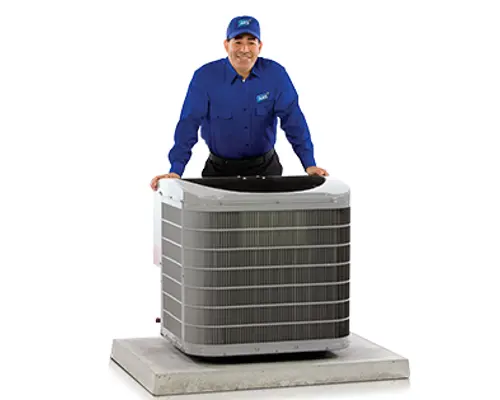
When enjoying the perfect temperature in your home, you might wonder what’s behind that comfort. Most homes use a central heating system, but understanding the components can be tricky. That’s where a common heating topic of discussion comes into play: Boiler vs. furnace—what’s the difference? How do they work? What do I have in my home?
Let’s dive into the differences between boiler and furnace systems and how they function. Whether you’re considering an upgrade or need service, ARS/Rescue Rooter is here to help. Call us at (866) 399-2885 for professional assistance with your heating system.
What Is a Furnace?
The term “furnace” comes from the Greek word “fornax,” which means oven. Early furnaces were stone or clay structures that used coal and/or wood to create intense heat for ceramic work and metal production. Over time, the concept evolved into the efficient home heating systems we rely on today.
How It Works
Clarifying how each unit functions is helpful when understanding the differences between boiler and furnace systems. Modern home furnaces typically run on gas, electricity, or induction.
They create concentrated heat in a safe, contained unit, which is then distributed through a ventilation system to warm your home. Small electric furnaces often support boilers and water heaters, ensuring access to hot water and heated living spaces.
Pros and Cons
Pros:
-
Efficient heat distribution: A furnace can quickly heat an entire home through a network of ducts.
-
Compatible with existing ductwork: Easily integrates with most homes’ existing duct systems.
-
Reliable and durable: Modern furnaces are built to last and provide consistent heat for many years.
-
Versatile fuel options: Available in gas, electric, and induction models to suit different preferences and needs.
Cons:
-
Can be noisy: The operation of the blower and other components can generate a lot of noise.
-
Requires regular maintenance: Furnaces need periodic inspections and tune-ups to ensure efficiency and longevity.
-
Higher upfront costs: Initial furnace installation can be expensive, though long-term savings can offset this cost.
-
Potential for air quality issues: Furnaces can circulate dust and allergens without proper filtration.
For any furnace-related services or inquiries, call ARS/Rescue Rooter at (866) 399-2885.
What Is a Boiler?
A boiler’s primary function is to turn water into steam, an efficient heat transfer medium. While air doesn't retain heat well, and water is challenging to move, steam is an excellent alternative. Boilers, like furnaces, are used in homes and various industrial applications.
How It Works
Boilers date back to the 1700s and have been used to power steam locomotives, steamboats, and industrial machinery. In homes, an attached gas or electric furnace heats the water, turning it into steam. The steam then circulates through a series of pipes and ducts to provide central heating.
This process can also be applied to water heaters, which deliver hot water for household use. Boilers are highly efficient, turning steam back into water to be reheated and reducing the need for separate heating systems and water heaters.
Pros and Cons
Pros:
-
Efficient heat transfer: Steam heats rooms more evenly and retains heat longer than air.
-
Quiet operation: Boilers generally operate more quietly than furnaces.
-
Dual-purpose functionality: A boiler can heat a home and its water supply.
-
Energy efficiency: Closed-loop systems recycle steam, reducing energy waste.
-
Longevity: A boiler typically has a slightly longer lifespan than the average furnace.
-
Versatile fuel options: Can be powered by various fuel options, including natural gas, propane, electricity, wood pellets, or fuel oil.
Cons:
-
Higher installation costs: Installing a boiler system can be more expensive than a furnace.
-
Complex maintenance: Boilers require specialized maintenance to ensure efficiency and safety.
-
Slower heat-up time: Boilers can take longer to heat up compared to furnaces.
For expert boiler services or inquiries, be sure to call ARS/Rescue Rooter at (866) 399-2885. We can further explain a boiler vs. a furnace and identify the right option for your space.
The Differences Between a Boiler and a Furnace at a Glance
|
Boiler |
Furnace |
|
|
Heating Comfort |
Provides radiant heating and requires a separate cooling system |
Delivers forced air heating and often integrates with central air conditioning. |
|
Cost |
Higher initial expenses |
Typically has lower upfront costs |
|
Energy Efficiency |
Achieves up to 95% Annual Fuel Utilization Efficiency (AFUE) |
Can reach up to 98.5% AFUE |
|
Fuel Source |
Operates on natural gas, fuel oil, propane, electricity, or wood pellets |
Uses natural gas, propane, oil, or electricity |
|
Indoor Air Quality |
Does not circulate airborne particles |
Circulates airborne particles through an air filter |
|
Ductwork |
Does not require ductwork |
Requires ductwork for air distribution |
|
Radiators |
Can be added wherever heat is needed |
N/A |
|
Water or Steam Piping |
Utilizes water or steam piping. |
N/A |
Boiler vs. Furnace: Get Professional Help to Choose the Best Option
Understanding the difference between boiler and furnace systems is crucial in maintaining a comfortable indoor atmosphere. While both provide warmth, the systems rely on different mechanisms.
A furnace primarily heats and circulates the air through your home, ensuring each room stays warm. On the other hand, a boiler heats water to provide heat and hot water for daily needs like showers and dishwashing.
Choosing between a boiler vs. a furnace often comes down to the building’s age and your personal preference. Older homes might benefit more from boiler systems, while newly constructed homes usually contain furnaces. The ultimate goal is to ensure comfort and warmth, regardless of the season.
To make the best decision for your heating needs, consult the experts at ARS/Rescue Rooter. Our team can help you determine your home's most efficient and effective heating solution. Call us today at (866) 399-2885 or schedule service online.
Frequently Asked Questions
How Do I Know If I Have a Boiler vs. a Furnace?
Check for radiators or baseboard heaters in your home—these indicate a boiler. Boilers also typically connect to hot water taps. You likely have a furnace if your home has vents connected to a centralized duct system.
How Long Will a Boiler Last?
A well-maintained boiler can last between 20 and 30 years, depending on the type, usage, and regular maintenance schedule.
Is a Boiler Safer than a Furnace?
Boilers and furnaces are both safe when properly maintained. However, boilers are often considered safer because they do not circulate dust and allergens through ducts and have fewer risks of gas leaks or carbon monoxide emissions.






